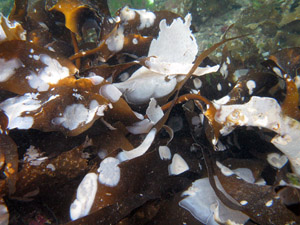
Community - University Research for Recovery Alliance

A project on the invasive species - Bryozoan Membranipora membranacea
 The invasive bryozoan Membranipora membranacea was introduced to the Gulf of Maine (USA), presumably in the ballast waters of European vessels in the mid 1980's, where it rapidly became the dominant epiphyte on kelps (large brown seaweeds in the order Laminariales). Since then it has migrated northward and can be found along the coasts of Nova Scotia, Québec, and Newfoundland and Labrador. Cyphonautes larvae settle on kelp during the spring and early summer. They asexually produce numerous individuals (zooids) in concentric rows to form circular colonies that range from a few millimetres to tens of centimetres in diameter. The presence of these colonies can have negative effects on kelp populations by reducing growth rates and reproduction, while simultaneously weakening kelp tissues, making them susceptible to wave induced defoliation. Annual decreases in kelp abundance and canopy cover may affect the community structure of benthic, subtidal habitats and facilitate the introduction of new invasive species.
The invasive bryozoan Membranipora membranacea was introduced to the Gulf of Maine (USA), presumably in the ballast waters of European vessels in the mid 1980's, where it rapidly became the dominant epiphyte on kelps (large brown seaweeds in the order Laminariales). Since then it has migrated northward and can be found along the coasts of Nova Scotia, Québec, and Newfoundland and Labrador. Cyphonautes larvae settle on kelp during the spring and early summer. They asexually produce numerous individuals (zooids) in concentric rows to form circular colonies that range from a few millimetres to tens of centimetres in diameter. The presence of these colonies can have negative effects on kelp populations by reducing growth rates and reproduction, while simultaneously weakening kelp tissues, making them susceptible to wave induced defoliation. Annual decreases in kelp abundance and canopy cover may affect the community structure of benthic, subtidal habitats and facilitate the introduction of new invasive species.

The objectives of this project were:
- To assess spatial and temporal (seasonal and interannual) variations in the abundance of M. membranacea along the west coast of Newfoundland and southeast coast of Labrador.
- To test the general hypothesis that spatial and temporal variation in the abundance of M. membranacea is positively correlated with temperature, being generally higher and lower in locations with warmer and colder thermal histories, respectively.
- To experimentally determine effects of temperature on the growth and morphology of M. membranacea colonies.
General results: Along the west coast of Newfoundland, M. membranacea was most abundant in the Bay of Islands and Bonne Bay. North of these locations, the abundance of the bryozoan decreased, with the smallest populations observed along the Strait of Belle Isle. In Port aux Basques, the abundance of M. membranacea was low, which may be caused by the offshore transport of larvae during annual upwelling in the fall. In Newfoundland, colonies of M. membranacea are most abundant between September and November.
This project was funded by the Institute for Biodiversity Ecosystem Science and Sustainability (IBES) at Sir Wilfred Grenfell College.
Researchers and Partners
Lead Researcher:
Patrick
Gagnon, Cold Ocean Benthic Ecology Lab (COBEL)
Researcher:
Robert Hooper
Student:
Scott Caines, M.Sc. Biology
Community Partners:
Institute
for Biodiversity and Ecosystem Science and Sustainability (IBES)
Photos
 |

|
 Marine Station
Marine Station

